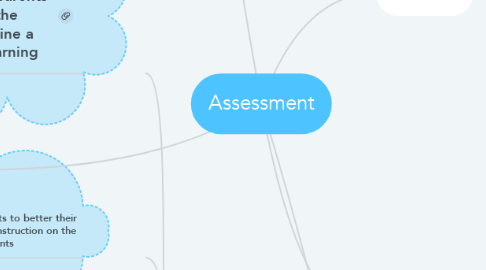Assessment
by Angelika Dymek


1. Effect on Lessons
1.1. Determines what strategy to focus on
1.1.1. Visual
1.1.2. Meaning
1.1.3. Structural
1.1.4. Visualizing
1.1.5. Making Connections
1.1.5.1. Connections to self
1.1.5.2. Connections to world
1.1.5.3. Connections to community
1.1.6. Predicting
1.1.7. Structural
1.2. Determines what letters or words to focus on
1.2.1. Sounds
1.2.2. Formation
1.2.3. Letter blends
1.3. Creating Groups
1.3.1. Guided Reading
1.3.2. Literacy Groups
1.3.3. Reading Buddies
1.4. Determines each student's needs
2. The 5 Ws and H
2.1. Who: The educator who is assessing, the student who is being assessed, the parents who can provide support at home, the school who can support and determine a school wide portfolio for literacy learning
2.2. What: Assessing students to better their learning and to focus our instruction on the specific needs of our students
2.3. When: It should be ongoing and consistent
2.4. Where: In the classroom, playground, community (anywhere!)
2.5. Why: To determine what your students know and what their and your next step is
2.6. How: Authentically and formally. It can be done with a pencil and paper, google forms, and through interviewing.
3. Resources
3.1. The Observation Survey
3.1.1. Letter/Word Assessment
3.1.1.1. Concept of Print
3.2. Running Records
3.3. PM Benchmarks
3.4. CASI
4. Purpose
4.1. To determine next step
4.2. For the educator to reflect on the teaching and learning within the classroom
4.3. capture student’s understanding by them doing, showing and telling
4.4. Guides planning for lessons
5. Types of Assessment
5.1. Diagnostic
5.1.1. This is done before any instruction/lessons begin Determines strategies the child is using
5.2. Formative
5.2.1. Done on an ongoing basis to track progress
5.3. Summative
5.3.1. Completed at the end to determine whether goals have been met
5.4. Authentic
5.4.1. Has meaning to real-life scenarios (realistic)
